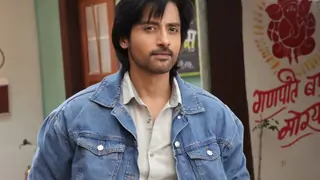Bahadur Khan
| |
Ustad Bahadur Khan is considered to be one of India's greatest Sarode maestros of all times.
Bahadur Khan was born in January 19, 1931 in Shibpur, Comillah, Bangladesh, (then British India), and he died on October 3, 1989 in Calcutta India. He is the son of famous Indian classical musician Ustad Hayat Ali Khan, nephew of the father of North Indian Classical Music Baba Allauddin Khan, cousin of the godfather of present Sarode Ustad Ali Akbar Khan and the best living Sitar player Srimati Annapurna Devi, and cousin-in-law of India's most celebrated classical musician Pandit Ravi Shankar.
No one got the instrument to yield with so many nuances like Khan. His style of playing Sarode was distinct and peerless, for he could bring a lump in the throat of connoisseurs as well as the layman. His strokes had unbelieveable control and his tone was amazingly rich and his odd squeaky musical notes a rarity. He was at his best when he revealed the aesthetic profoundity of a given Raga through his scintillating melodies. With a few deftly placed notes, he would sketch out the contours step by step and then gradually bring out the soul of the Raga chosen by him. There was no striving for abstraction by making frequent note clusters at the expense of the central melody as many of today's both vocalists and instrumentalists now do.
Khan was a highly acclaimed performer of his time and won rave popularity all over the Indian subcontinent for his musical genius. He was like a cultural ambassador of the nation at many occasions and his admirers were too many to name, few of them being Indian Prime Ministers Jawaharlal Nehru, Indira Gandhi, Jaipur Royal Gayatri Devi, Chinese Chairman Mao Zedong and Chinese Premier Zhou Enlai. Khan has extensively traveled Europe, Asia, and North America to perform his music; and was an honorary delegate of India to the former USSR and China several times. Whenever he played Sarode duett with Baba Allauddin Khan or Ustad Ali Akbar Khan, he gave out an elusive, mystical quality in the rendering where both erotica and devotion mingle. No wonder, it captivated his audience who, tears rolliing down their cheeks, left with a perennial impression not to be erased in their lifetime. In sum, pathos, poignancy, serenity and layakari or control of rhythms in a Raga were enduring.
Bahadur Khan was one of the most popular regular performers at the All India Radio and Radio Pakistan. He composed and directed music for almost all the films of the legendary Indan filmmaker Ritwik Ghatak. He received the best music director award for Ritwik Ghatak's film Subarnarekha. Other films that brought out his musical virtuosity into celluloid were Meghe Dhaka Tara, Komal Gandhar, Jukti Takko Ar Gappo, Titas Ekti Nodir Naam, Shwet Mayur, Yekhane Dariye, Trisandhyay, Notun Pata, Garam Hawa and Ajantrik to name a few. He also directed music on documentaries on renowned poet Rabindranath Tagore and painter Jamini Roy, and was also a very highly esteemed figure in the film-music industries of Bombay and Calcutta.
Musiclovers of the world did not get what they eminently deserved from this artiste extraordinaire for his introvert, withdrawn and somewhat eremitic nature. But still he remained a legend like to all the connoiseurs of music everywhere in India just like another reclusive legend Srimati Annapurna Devi, who is Bahadur Khan's cousin, and Pandit Ravi Shankar's first wife and teacher. In his untimely death in 1989, India lost a musical virtuoso who had the genius of enriching Indian classical music in no lesser way than his fellow musical legends like Ustad Ali Akbar Khan, Pandit Ravi Shankar Pandit Nikhil Banerjee and Vasant Rai of the Senia Maihar School of Music or Senia Maihar Gharana. Ustad Bahadur Khan used to say " I can beg in streets, but music is my God, and I am never interested in commercially selling my god, my worship in a dishonest way to earn money. " He was a true saint in the family of saintly musicians like his uncles Baba Allauddin Khan, Fakir Aftabuddin and his cousin Srimati Annapurna Devi.
Bahadur Khan created beautiful Ragas like Milanmadhuri, Dayabati, Debapriya, and Bahaduri Kanara (which was first broadcasted from Dhaka Radio Station). Some of his performances are commercially available in India, Europe and North America in the forms of cassettes and discs.
Bahadur Khan has taught music in Calcutta as well as at his cousin Ali Akbar Khan's Ali Akbar College of Music in California, USA. Bahadur Khan's eminent students, Bidyut Khan, Shahdat Hossain Khan, Tejendranarayan Majumdar, and Kalyan Mukherjee in Sarode and Manoj Shankar in Sitar are renowned classical musicians and performers of the present generation who are carrying on with themselves the legacy of Ustad Bahadur Khan.
Every year, a huge music concert takes place in Calcutta commemorating Ustad Bahadur Khan.




























